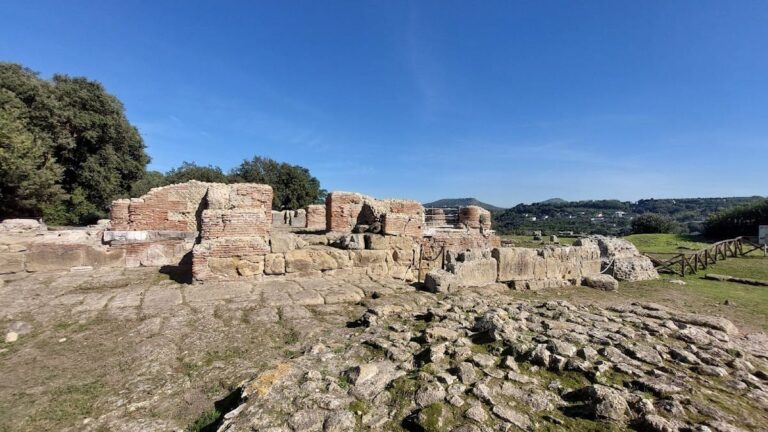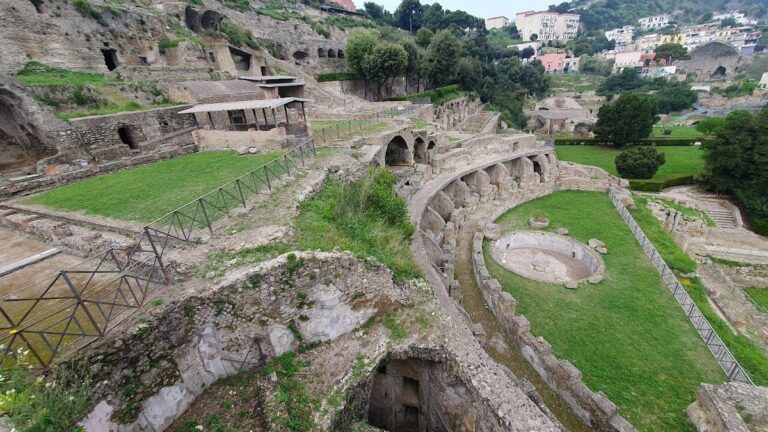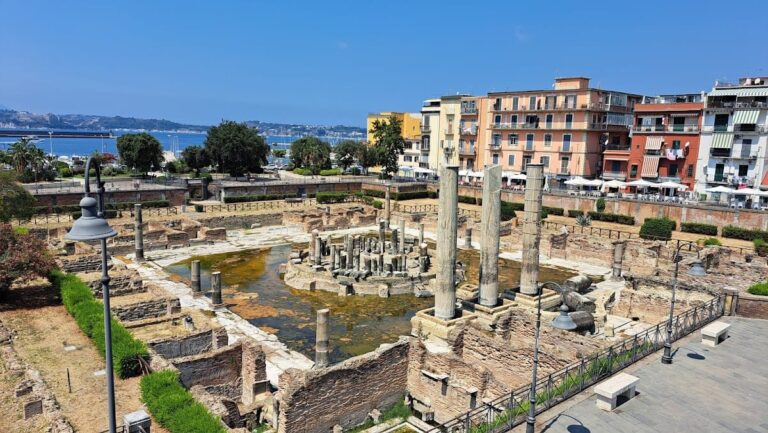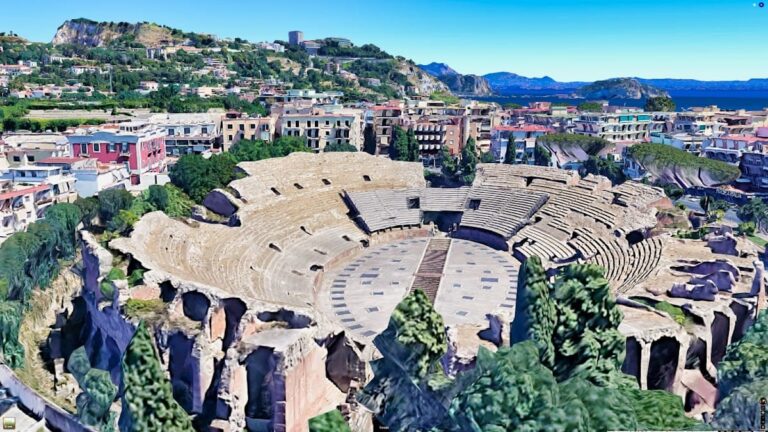Liternum: An Ancient Roman Colony in Campania, Italy
Table of Contents
Visitor Information
Google Rating: 4
Popularity: Low
Google Maps: View on Google Maps
Official Website: www.pafleg.it
Country: Italy
Civilization: Roman
Remains: City
Context
Liternum is situated within the modern municipality of Giugliano in Campania, in the province of Naples, southern Italy. The site occupies a low-lying coastal plain northwest of the Bay of Naples, adjacent to Lago Patria, a lagoon that historically formed part of a complex wetland environment. The terrain is characterized by flat, sandy soils near the mouth of the ancient Clanis River and was once bordered by the Silva Gallinaria forest, providing natural resources and access to maritime routes.
Its location between the prominent Greek city of Cumae and the Volturnus River placed Liternum within a dynamic cultural and economic landscape of Campania. The site’s occupation began in the Roman Republican period and extended into late antiquity. Notably, it is recorded in classical literature as the retirement place of the Roman general Publius Cornelius Scipio Africanus. Archaeological evidence confirms continuous habitation until the early medieval period, after which environmental degradation and malaria outbreaks contributed to its abandonment. Today, the site’s remains lie in open countryside under Italian cultural heritage protection, offering valuable insights into Roman urbanism and regional history.
History
Pre-Roman and Oscan Period
Prior to Roman colonization, the area around Liternum was inhabited by Oscan-speaking populations, reflecting a longstanding indigenous presence in Campania. The site likely functioned within the sphere of influence of the nearby Greek polis of Cumae, which dominated the coastal region culturally and economically from the 8th century BCE onward. Although direct archaeological evidence from this early phase is limited, the settlement’s location suggests it may have served as a dependent or satellite community, benefiting from Cumaean trade networks and agricultural exploitation of the fertile coastal plain.
Roman Republican Period (194–1st century BCE)
Liternum was formally established as a Roman colony in 194 BCE, probably settled by veterans of the Second Punic War, many of whom had served under Publius Cornelius Scipio Africanus. The colony’s foundation was part of Rome’s broader strategy to secure Campania following the Punic conflicts. Positioned strategically on the coast between Cumae and the Volturnus River, near the mouth of the Clanis River and adjacent to the Silva Gallinaria forest, Liternum occupied a site advantageous for both defense and resource exploitation.
Historical sources record that Scipio Africanus retired to Liternum around 187 BCE and died there in 183 BCE. His villa and tomb became notable landmarks, later described by Seneca the Younger in the 1st century CE. Early accounts, including those by Livy, suggest the colony initially struggled to prosper; however, archaeological data indicate continuous occupation throughout the Republican period. The urban plan included a forum with porticoes on three sides, a Capitolium and basilica dating to the 2nd century BCE, and a small theater constructed by the late 2nd century BCE. Additionally, a temple and a thermal building from the late Republican era have been identified, reflecting gradual urban development and civic organization.
Augustan and Imperial Roman Period (1st century BCE – 3rd century CE)
During the Augustan period and continuing through the 1st and 2nd centuries CE, Liternum experienced notable growth, largely stimulated by the construction of the Via Domitiana. This road enhanced connectivity between Liternum, other Campanian centers, and the major port of Puteoli, integrating the colony more fully into regional economic and administrative networks. The city attained the status of a prefecture, indicating its elevated administrative role within the province.
The urban fabric adapted to the Via Domitiana, which traversed the forum area in a north-south direction, necessitating modifications to the porticoes. Public entertainment infrastructure included an amphitheater built in the late Republican period and restored during the Imperial era, measuring approximately 85–90 by 65–70 meters. A small theater and basilica within the city walls further attest to the colony’s civic amenities. Outside the city, a necropolis spanning over 150 square meters contains more than twenty tombs dating from the late 1st century BCE to the 3rd century CE. The necropolis features diverse burial types, including brick box tombs, terracotta jar burials (enchytrismos), and mausolea constructed with opus reticulatum masonry. Funerary artifacts such as coins, oil lamps, and ceramics provide valuable information on local customs. A rare marble funerary inscription dedicated to a gladiator was discovered here, evidencing the presence and social recognition of gladiators within the community.
Economic activities during this period included fishing and the probable exploitation of the fine white sand along the coast, possibly for glass production. Archaeological finds of workshop debris, glass fragments, and ceramic remains indicate artisanal production, including perfumery and ceramics, contributing to a diversified local economy.
Late Antiquity and Vandal Period (4th–5th century CE)
From the 4th century CE onward, Liternum underwent a gradual decline, influenced by environmental changes such as increasing marshification and recurrent malaria outbreaks that rendered the coastal plain less habitable. These conditions prompted a demographic shift, with inhabitants relocating inland to establish what would become the historic center of modern Giugliano. Despite this decline, Liternum retained ecclesiastical significance as a Christian episcopal seat, known as ecclesia Liternina or Patriensis. The translation of the relics of Saint Fortunata from Liternum to Naples underscores its religious importance during this period.
In 455 CE, the settlement suffered destruction during the Vandal invasion led by King Genseric, marking a critical event in its decline. By the early medieval era, the surrounding plains were occupied by Benedictine monks, who transformed the landscape for monastic agriculture and spiritual retreat, signaling a shift from urban to rural ecclesiastical land use.
Medieval Period and Abandonment
By the early Middle Ages, Liternum was effectively abandoned as a residential center due to persistent environmental degradation and health hazards. Archaeological investigations have not identified significant medieval occupation layers, confirming the cessation of urban life. The population’s relocation to higher, healthier ground led to the foundation of the nucleus of modern Giugliano. The area’s function transitioned to monastic landholding and agricultural use under Benedictine influence, with dispersed rural settlement patterns replacing the former urban structure.
Modern Rediscovery and Archaeological Investigations (19th century – present)
The identification of Liternum’s ancient remains began in the late 19th century through the discovery of inscriptions and early surveys. Systematic archaeological excavations commenced in the 1930s under the direction of Amedeo Maiuri, revealing key elements of the city’s layout, including the forum, Capitolium, basilica, theater, and sections of the Via Domitiana. The amphitheater and necropolis were also uncovered, providing comprehensive insight into the city’s urban organization and funerary practices.
In 1936, a votive altar dedicated to Scipio Africanus was erected on site, commemorating the colony’s most renowned inhabitant. Many artifacts recovered during excavations are preserved in the Museo Archeologico dei Campi Flegrei. Since 2006, coordinated efforts by local authorities and heritage organizations have developed the Parco Archeologico di Liternum, enhancing conservation and facilitating scholarly research. Recent restoration projects, including the rehabilitation of the naturalistic park adjacent to the forum excavations, have improved site preservation. Ongoing archaeological investigations continue to refine understanding of Liternum’s historical trajectory and urban development.
Remains
Architectural Features
The archaeological remains at Liternum predominantly date from the Roman Republican and Imperial periods, reflecting the city’s development over several centuries. The urban layout centers on a forum approximately 97 by 42 meters in size, originally porticoed on three sides. The Via Domitiana, constructed in the 1st century CE, bisected the forum along a north-south axis, necessitating partial reconstruction of the porticoes.
Construction techniques include opus reticulatum masonry, particularly evident in funerary monuments, and squared stone blocks used in prominent buildings such as the villa attributed to Scipio Africanus. The city’s fabric comprises public entertainment venues, religious structures, residential quarters, and workshop areas. Over time, expansions and restorations occurred mainly during the 1st and 2nd centuries CE. Environmental deterioration and health issues contributed to the site’s decline and eventual abandonment by the early Middle Ages.
Key Buildings and Structures
Forum
The forum, established at the colony’s foundation in 194 BCE, functioned as the civic and commercial heart of Liternum. Measuring approximately 97 meters in length and 42 meters in width, it was surrounded on three sides by porticoes. The northern side contained the Capitolium and basilica, both dating to the 2nd century BCE. Excavations conducted between 1930 and 1936 revealed these structures alongside a small podium temple from the colony’s early phase. The later construction of the Via Domitiana through the forum’s center required partial rebuilding of the portico, illustrating the city’s adaptation to evolving infrastructure.
Capitolium
Situated on the northern side of the forum, the Capitolium dates to the 2nd century BCE and was partially excavated in the 1930s. The remains include foundations and architectural fragments consistent with Republican temple construction. Although only partial structural elements survive, the building’s location and design confirm its role as a principal religious edifice dedicated to the Capitoline triad.
Basilica
Adjacent to the Capitolium on the forum’s northern side, the basilica also dates to the 2nd century BCE. Excavations uncovered foundations and wall fragments indicative of a typical Republican civic building used for legal and commercial activities. The surviving remains are fragmentary but sufficient to establish its function within the forum complex.
Theater
A small theater dating to the late 2nd century CE lies near the forum, positioned to the right when facing the temple remains. Excavated in the 1930s, the theater’s stage building (skenè) remains are visible, while seating and other architectural components survive only in part. The modest size of the venue suggests it served local public performances and social gatherings.
Temple (Podium Temple in Forum)
An early podium temple, constructed during the initial phase of the colony, is located within the forum complex. Excavations revealed podium and foundation elements dating to the early Republican period. Although superstructures are largely lost, the temple’s remains confirm its presence as a focal point of religious activity within the civic center.
Amphitheater
The amphitheater is situated outside the city walls near the southern area by the lake mouth. Built in the 1st century BCE, it measures approximately 85–90 meters by 65–70 meters. The structure underwent restorations during the 1st and 2nd centuries CE. Surface remains and structural traces identified through archaeological surveys indicate its use for gladiatorial games and public spectacles. While much of the superstructure is lost, the masonry and layout remain partially preserved.
Necropolis
The necropolis lies outside the city walls, near the forum and amphitheater, covering an area exceeding 150 square meters. It contains over twenty tombs dating from the late 1st century BCE to the 3rd century CE. Two funerary enclosures with partially preserved white plaster walls decorated with red motifs are present. A central mausoleum constructed in opus reticulatum masonry with gray tuff blocks and plastered niches for cinerary urns dominates one enclosure. Burial types include cappuccino tombs with gabled roof tiles, enchytrismos burials placing remains in large terracotta jars, and brick box tombs. A deep masonry well, likely associated with funerary cult practices, is also part of the site. A marble funerary inscription dedicated to a gladiator was discovered here, attesting to the burial of gladiators within the colony. The necropolis’s alignment suggests it originally lay along the ancient Via Domitiana.
Villa and Tomb of Scipio Africanus
The villa and tomb of Publius Cornelius Scipio Africanus are historically attested at Liternum. Seneca the Younger described the villa as constructed with squared stone blocks and featuring towers on both sides. The tomb reportedly bore the epitaph “Ingrata patria, ne ossa quidem mea habes” (“Ungrateful homeland, you do not even have my bones”). Excavations in the 1930s sought these structures, but only partial remains and inscriptions have been documented. A fragment of the epitaph was reportedly found among the ruins, contributing to the naming of the nearby Lago di Patria.
Temple and Thermal Building (Republican Era)
Remains of a temple and a thermal building dating to the Republican period (2nd–1st century BCE) have been identified within the urban area but outside the forum complex. The thermal building is interpreted as a bath complex, though details about its layout and features remain limited. The temple remains consist of foundation and podium elements uncovered during archaeological investigations.
Other Remains
Surface traces and low walls of various buildings have been recorded but not fully excavated or identified. Finds of glass fragments, slag, and ceramic debris suggest the presence of workshops, perfumeries, and ceramic production areas, though specific buildings remain unnamed. The urban area also includes remains of roads and drainage systems associated with the Via Domitiana, indicating infrastructural development within the city.
Archaeological Discoveries
Excavations at Liternum have yielded a variety of artifacts spanning the Republican through Imperial periods. Numerous coins, oil lamps, and ceramic vessels were recovered, particularly from the necropolis, aiding in dating and understanding burial customs. The funerary goods include locally produced ceramics and imported items, though specific origins are not detailed in the sources.
Inscriptions form an important category of finds, including a well-preserved marble funerary inscription dedicated to a gladiator. Other inscriptions relate to dedications, such as the votive altar to Scipio Africanus erected in 1936. These epigraphic materials provide direct evidence of individuals and social groups within the colony.
Pottery finds include amphorae, tableware, and storage jars, recovered from domestic and funerary contexts. Tools and workshop debris, including glass fragments and slag, indicate local artisan activities, possibly including glass production. Domestic objects such as oil lamps and cooking vessels have been found in various parts of the site, reflecting everyday life.
Preservation and Current Status
The preservation of Liternum’s remains varies by structure. The forum, Capitolium, basilica, and temple foundations survive in partial but identifiable form. The small theater retains visible elements of the stage building, while the amphitheater’s surface remains and structural traces are fragmentary. The necropolis is well-preserved in parts, with funerary enclosures and tombs protected under Italian heritage laws.
Since 2006, restoration and conservation efforts have been ongoing, including rehabilitation of the archaeological park and naturalistic areas adjacent to the forum. Excavations led by local authorities continue to reveal new funerary enclosures and inscriptions. The site is managed under the supervision of the Italian Ministry of Cultural Heritage, with stabilization and enhancement works completed as recently as 2024.
Unexcavated Areas
Several parts of Liternum remain unexcavated or poorly studied. Surface surveys have identified traces of buildings and infrastructure beyond the main excavated zones, including possible workshop areas and additional residential quarters. The full extent of the urban fabric, especially peripheral districts, has not been systematically explored. No detailed plans for future excavations have been specified, though conservation policies prioritize preservation of the site’s integrity.





